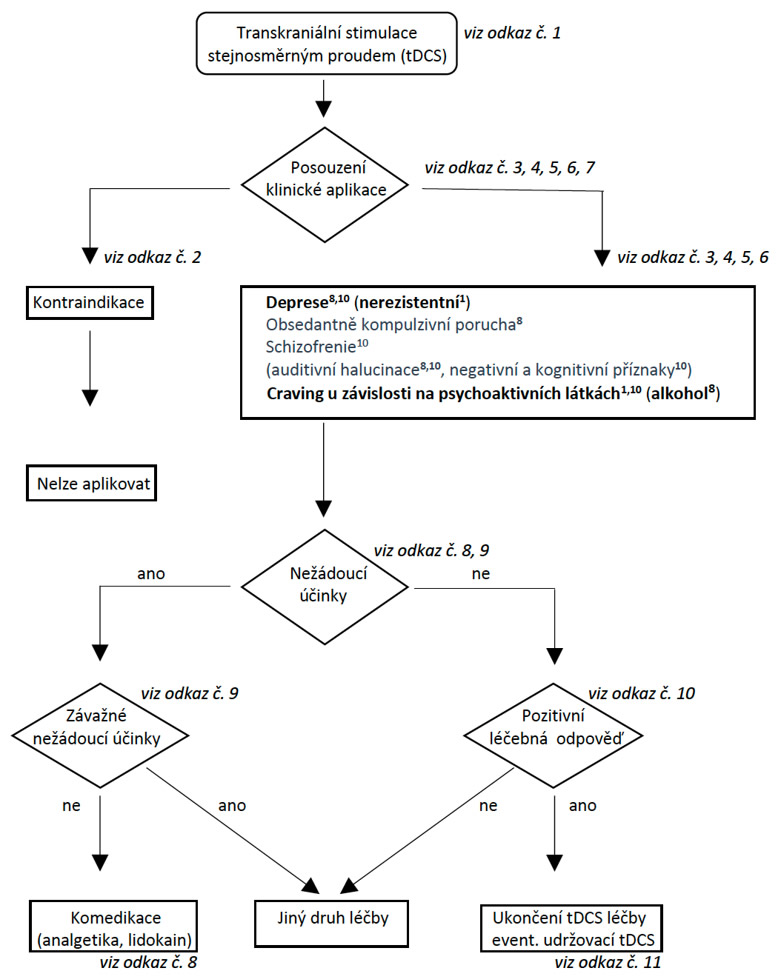Autoři: Klírová Monika, Novák Tomáš, Buday Jozef
Garant: Klírová Monika
Oponent: Kašpárek Tomáš, Ustohal Libor
Vysvětlivky:
ovál - nadpis
kosočtverec - výběr z více variant
přerušovaná čára - diagram pokračuje na další straně
Shrnutí
TDCS je bezpečná a dobře snášená experimentální léčebná metoda, která je podle aktuálních evropských doporučení pravděpodobně účinná v léčbě nerezistentní epizody deprese, nikoliv však v terapii epizod rezistentní deprese, rovněž je potenciálně účinná v cravingu u SUD. Dle dalších metaanalýz může být tDCS taktéž účinná v léčbě auditivních halucinací a negativních symptomů, poruchy pozornosti a pracovní paměti u schizofrenie nebo v léčbě OCD. Skutečný klinický dopad této metody je však třeba ověřit dalšími studiemi s odlišným designem.
Tabulka. Souhrn evropských doporučení pro tDCS dle klinické indikace u psychiatrických diagnóz (1)
|
Diagnóza |
Typ tDCS |
Umístění elektrod |
Úroveň účinku |
Účinnost |
|
|
anoda |
Katoda |
||||
|
deprese: nerezistentní na AD léčbu(15,20) |
anodální |
L-DLPFC (F3) |
P-OFC (FP2) |
B |
pravděpodobný účinek |
|
deprese: rezistentní na AD léčbu(9) |
anodální |
L-DLPFC (F3) |
P-OFC (FP2) |
B |
pravděpodobně neúčinná |
|
bihemisférická |
L-DLPFC (F3) |
P-DLPFC (F4) |
– |
není dostatečná |
|
|
craving u SUD(21) |
bihemisférická |
P-DLPFC (F4) |
L-DLPFC (F3) |
C |
potenciálně účinná |
důkaz účinku léčby: úroveň B – pravděpodobná (ne)účinnost, úroveň C – potenciální (ne)účinnost; AD – antidepresiva; tDCS – transkraniální stimulace stejnosměrným proudem; SUD – poruchy spojené s užíváním návykových látek; L-DLPFC – levý dorzolaterální prefrontální kortex; P-DLPFC – pravý dorzolaterální prefrontální kortex; P-OFC – pravý orbitofrontální kortex; F3, F4, FP2 značí umístění elektrod podle systému rozmístění elektroencefalografických (EEG) elektrod 10/20 (přejato a upraveno z Lefaucheur et al., 2017).
Literatura
- Lefaucheur JP, Antal A, Ayache SS, Benninger DH, et al. Evidence-based guidelines on the therapeutic use of transcranial direct current stimulation (tDCS). Clinical Neurophysiology 2017; 128(1), 56–92.
- Loo C, Martin D, Alonzo A, Gandevia S, et al. Avoiding skin burns with transcranial direct current stimulation: preliminary considerations. International Journal of Neuropsychopharmacology 2011; 14(3), 425–426.
- Shiozawa P, Da Silva ME, Raza R, Uchida RR, et al. Safety of repeated transcranial direct current stimulation in impaired skin: a case report. Journal of ECT 2013; 29(2), 147–148.
- Datta A, Bikson M & Fregni F. Transcranial direct current stimulation in patients with skull defects and skull plates: high-resolution computational FEM study of factors altering cortical current flow. Neuroimage 2010; 52(4), 1268–1278.
- Nitsche MA, Cohen LG, Wassermann EM, Priori A, et al. Transcranial direct current stimulation: state of the art 2008. Brain Stimulation 2008; 1(3), 206–223.
- Poreisz C, Boros K, Antal A & Paulus W. Safety aspects of transcranial direct current stimulation concerning healthy subjects and patients. Brain Research Bulletin 2007; 72(4–6), 208–214.
- Thair H, Holloway AL, Newport R & Smith AD. Transcranial direct current stimulation (tDCS): a beginner's guide for design and implementation. Frontiers in Neuroscience 2017; 11, 641.
- Fregni F, El-Hagrassy MM, Pacheco-Barrios K, Carvalho S, et al. Evidence-based guidelines and secondary meta-analysis for the use of transcranial direct current stimulation in neurological and psychiatric disorders. International Journal of Neuropsychopharmacology 2021; 24(4), 256–313.
- Li H, Cui L, Li J, Liu Y, et al. Comparative efficacy and acceptability of neuromodulation procedures in the treatment of treatment-resistant depression: a network meta-analysis of randomized controlled trials. Journal of affective disorders 2021; 287, 115-124.
- Hyde J, Carr H, Kelley N, Seneviratne R, et al. Efficacy of neurostimulation across mental disorders: systematic review and meta-analysis of 208 randomized controlled trials. Molecular psychiatry 2022; 27(6), 2709-2719.
- McLaren ME, Nissim NR & Woods AJ. The effects of medication use in transcranial direct current stimulation: a brief review. Brain stimulation 2018, 11(1), 52-58.
- Brunoni AR, Ferrucci R, Bortolomasi M, Scelzo E, et al. Interactions between transcranial direct current stimulation (tDCS) and pharmacological interventions in the Major Depressive Episode: findings from a naturalistic study. European Psychiatry 2013, 28(6), 356-361.
- Brunoni AR, Valiengo L, Baccaro A, et al. The sertraline vs electrical current therapy for treating depression clinical study: results from a factorial, randomized, controlled trial. JAMA Psychiatry 2013; 70(4), 383–391.
- Woods AJ, Antal A, Bikson M, Boggio PS, et al. A technical guide to tDCS, and related non-invasive brain stimulation tools. Clinical Neurophysiology 2016; 127(2), 1031–1048.
- KLÍROVÁ, Monika. Neinvazivní mozková stimulace v psychiatrii: Od experimentálního výzkumu ke klinické aplikaci. Praha: Maxdorf, 2022. 102 s. ISBN 978-80-7345-719-8.
- Matsumoto H & Ugawa Y. Adverse events of tDCS and tACS: a review. Clinical Neurophysiology Practice 2017; 2, 19–25.
- Macher JP & Crocq MA. Treatment goals: response and nonresponse. Dialogues in Clinical Neuroscience 2004; 6(1), 83–91.
- Milev RV, Giacobbe P, Kennedy SH, Blumberger DM, et al. Canadian Network for Mood and Anxiety Treatments (CANMAT) 2016 clinical guidelines for the management of adults with major depressive disorder: section 4. Neurostimulation treatments. The Canadian Journal of Psychiatry 2016; 61(9), 561-575.
- Martin DM, Alonzo A, HO K-A, et al. Continuation transcranial direct current stimulation for the prevention of relapse in major depression. Journal of Affective Disorders 2013; 144(3), 274–278.
- Brunoni AR, Moffa AH, Sampaio-Junior B, et al. Trial of electrical direct-current therapy versus escitalopram for depression. New England Journal of Medicine 2017; 376(26), 2523–2533.
- Klauss J, Anders QS, Felippe LV, et al. Multiple sessions of transcranial direct current stimulation (tDCS) reduced craving and relapses for alcohol use: a randomized placebo-controlled trial in alcohol use disorder. Frontiers in Pharmacology 2018; 9, 716.
Datum zveřejnění: 15.1.2023

